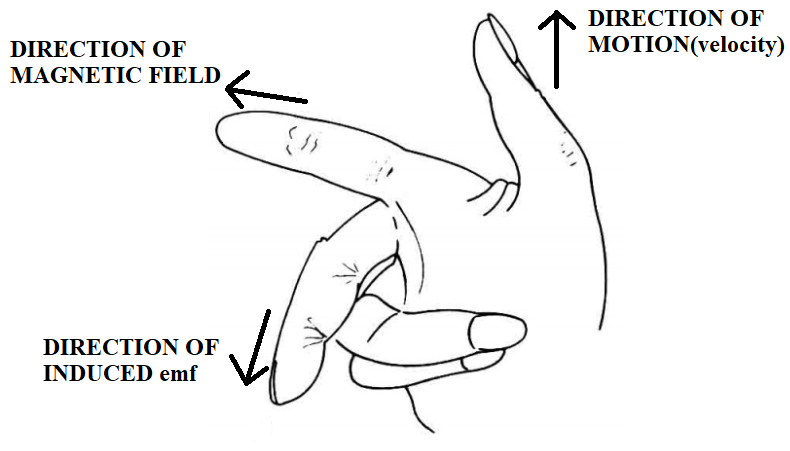
Direction of induced emf can be found from
A) Lenz law
B) Laplace law
C) Fleming law
D) None of the above
Answer
571.5k+ views
Hint: When a moving charge passes through a magnetic field, an emf is induced in the charge. The direction of induced emf is perpendicular to the direction of magnetic field as well as the direction of velocity of the charge. This direction can be determined by right-hand rule.
Complete answer:
When a charge is made to move in a magnetic field, an emf is induced in the charge. The direction of this induced emf is perpendicular to both the direction of magnetic field and the direction of motion of the charge. We can easily determine the direction of induced emf with the help of Fleming’s right-hand rule.
Now, let us understand Fleming’s right-hand rule. The right hand is held in such a way that the thumb finger, index finger and the middle finger are mutually perpendicular to each other as shown in the following figure. Fleming’s right-hand rule suggests that: If the thumb finger is pointed in the direction of motion or velocity of the charge, and if the index finger is pointed in the direction of magnetic field, then, the middle finger represents the direction of induced emf of the charge. The figure given below explains the same clearly.

Therefore, the direction of induced emf is given by Fleming’s law .
The correct answer to be marked is option C.
Additional information:
When a moving charge encounters a magnetic field, an emf is induced in the charge. This is due to Faraday’s law of induction, which says that induced emf is equal to the rate of change of magnetic flux. Faraday’s law of induction is given by
$e=-\dfrac{d\Phi }{dt}$
where
$e$ is the induced emf
$\dfrac{d\Phi }{dt}$ is the rate of change of magnetic flux
Note:
Students need not get confused with Lenz’s law for this question. Lenz’s law suggests that the direction of induced emf opposes the change in magnetic flux. The negative sign in Faraday’s law can be related to this law. Lenz’s law gives the direction of induced emf with respect to the change in magnetic flux but Fleming’s law gives the direction of induced emf more accurately. But if the question talks about the change in magnetic flux, students may have to go with Lenz’s law. Students can easily rule out option B too, because Laplace law talks about the relationship between pressure and volume in spheres.
Complete answer:
When a charge is made to move in a magnetic field, an emf is induced in the charge. The direction of this induced emf is perpendicular to both the direction of magnetic field and the direction of motion of the charge. We can easily determine the direction of induced emf with the help of Fleming’s right-hand rule.
Now, let us understand Fleming’s right-hand rule. The right hand is held in such a way that the thumb finger, index finger and the middle finger are mutually perpendicular to each other as shown in the following figure. Fleming’s right-hand rule suggests that: If the thumb finger is pointed in the direction of motion or velocity of the charge, and if the index finger is pointed in the direction of magnetic field, then, the middle finger represents the direction of induced emf of the charge. The figure given below explains the same clearly.

Therefore, the direction of induced emf is given by Fleming’s law .
The correct answer to be marked is option C.
Additional information:
When a moving charge encounters a magnetic field, an emf is induced in the charge. This is due to Faraday’s law of induction, which says that induced emf is equal to the rate of change of magnetic flux. Faraday’s law of induction is given by
$e=-\dfrac{d\Phi }{dt}$
where
$e$ is the induced emf
$\dfrac{d\Phi }{dt}$ is the rate of change of magnetic flux
Note:
Students need not get confused with Lenz’s law for this question. Lenz’s law suggests that the direction of induced emf opposes the change in magnetic flux. The negative sign in Faraday’s law can be related to this law. Lenz’s law gives the direction of induced emf with respect to the change in magnetic flux but Fleming’s law gives the direction of induced emf more accurately. But if the question talks about the change in magnetic flux, students may have to go with Lenz’s law. Students can easily rule out option B too, because Laplace law talks about the relationship between pressure and volume in spheres.
Recently Updated Pages
Master Class 12 Business Studies: Engaging Questions & Answers for Success

Master Class 12 Economics: Engaging Questions & Answers for Success

Master Class 12 English: Engaging Questions & Answers for Success

Master Class 12 Maths: Engaging Questions & Answers for Success

Master Class 12 Social Science: Engaging Questions & Answers for Success

Master Class 12 Chemistry: Engaging Questions & Answers for Success

Trending doubts
What is meant by exothermic and endothermic reactions class 11 chemistry CBSE

Which animal has three hearts class 11 biology CBSE

10 examples of friction in our daily life

One Metric ton is equal to kg A 10000 B 1000 C 100 class 11 physics CBSE

1 Quintal is equal to a 110 kg b 10 kg c 100kg d 1000 class 11 physics CBSE

Difference Between Prokaryotic Cells and Eukaryotic Cells




